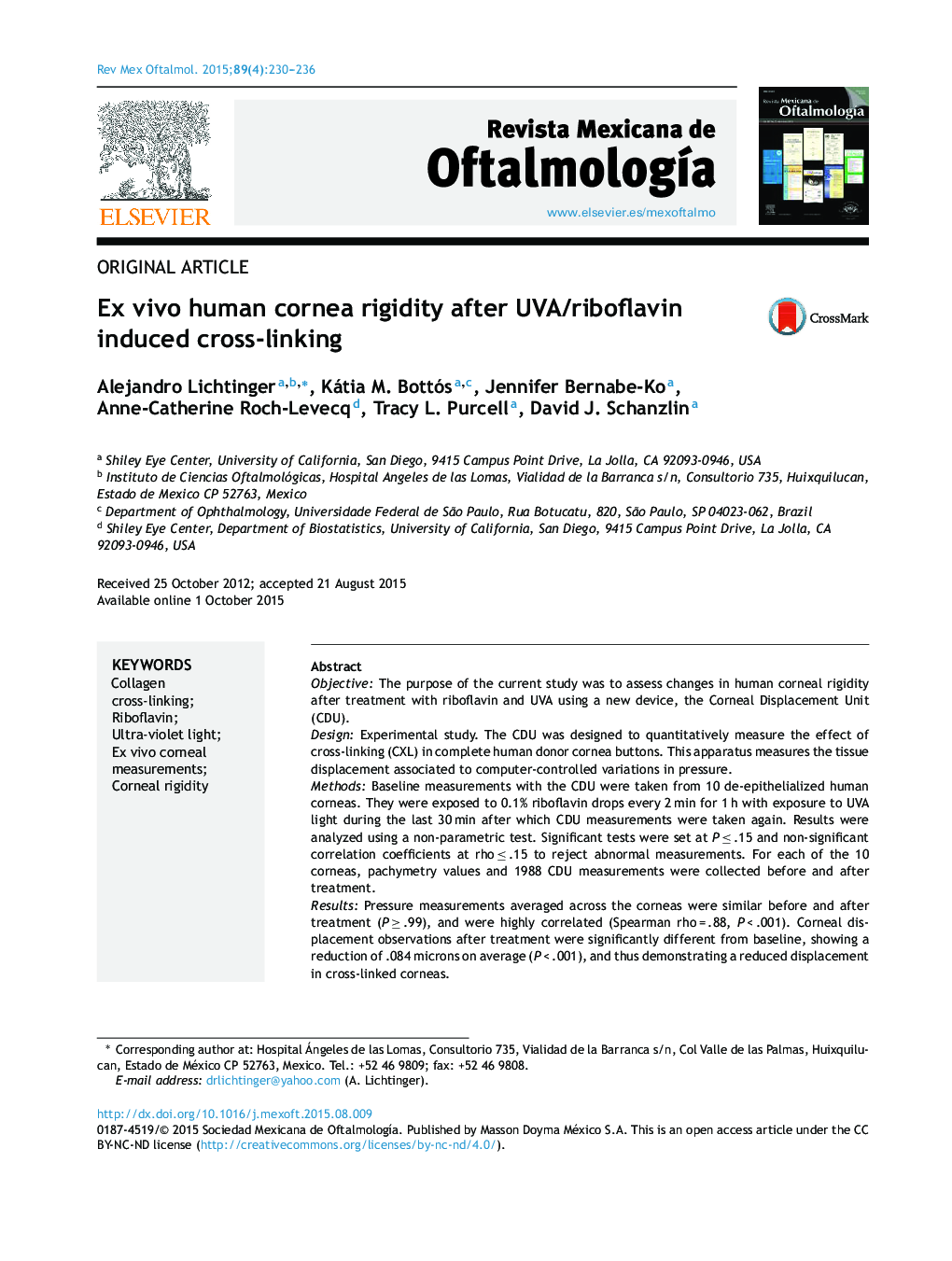| کد مقاله | کد نشریه | سال انتشار | مقاله انگلیسی | نسخه تمام متن |
|---|---|---|---|---|
| 4032351 | 1263047 | 2015 | 7 صفحه PDF | دانلود رایگان |

ObjectiveThe purpose of the current study was to assess changes in human corneal rigidity after treatment with riboflavin and UVA using a new device, the Corneal Displacement Unit (CDU).DesignExperimental study. The CDU was designed to quantitatively measure the effect of cross-linking (CXL) in complete human donor cornea buttons. This apparatus measures the tissue displacement associated to computer-controlled variations in pressure.MethodsBaseline measurements with the CDU were taken from 10 de-epithelialized human corneas. They were exposed to 0.1% riboflavin drops every 2 min for 1 h with exposure to UVA light during the last 30 min after which CDU measurements were taken again. Results were analyzed using a non-parametric test. Significant tests were set at P ≤ .15 and non-significant correlation coefficients at rho ≤ .15 to reject abnormal measurements. For each of the 10 corneas, pachymetry values and 1988 CDU measurements were collected before and after treatment.ResultsPressure measurements averaged across the corneas were similar before and after treatment (P ≥ .99), and were highly correlated (Spearman rho = .88, P < .001). Corneal displacement observations after treatment were significantly different from baseline, showing a reduction of .084 microns on average (P < .001), and thus demonstrating a reduced displacement in cross-linked corneas.ConclusionsThe present study demonstrated a significant increase in the mechanical rigidity of human corneas after CXL. The CDU was able to quantify the mechanical strength of whole corneal buttons ex vivo with minimal damage to the tissue.
ResumenObjetivoEl objetivo de este estudio fue estudiar los cambios en la rigidez corneal tras el tratamiento con Riboflavina y luz ultravioleta (UVA) utilizando un nuevo aparato, la unidad de desplazamiento corneal (CDU).DiseñoEstudio experimental. El CDU fue diseñando para medir cuantitativamente el efecto del cross-linking (CXL) en botones corneales humanos. El instrumento mide el desplazamiento asociado a variaciones en la presión controladas por computadora.MétodosTomamos medidas basales con el CDU en 10 corneas tras remover el epitelio. Las corneas fueron expuestas a Riboflavina 0.1%, 1 gota cada 2 minutos durante 1 hora con exposición a UVA durante los últimos 30 minutos, al finalizar se tomaron mediciones con el CDU nuevamente. los resultados fueron analizados con prueba no paramétrica., La validez se estableció con P ≤ .15 y el coeficiente de correlación no significativo en rho ≤ .15 para descartar mediciones anormales. Para cada cornea, valores paquimétricos y 1988 mediciones del CDU fueron tomadas antes y después del CXL.ResultadosLos valores promedio de presión entre las corneas fueron similares antes y después del tratamiento. (P ≥ 0.99), con una alta congruencia (Spearman rho = 0.88, P < 0.001) a diferencia de las mediciones de desplazamiento, donde los valores después de CXL mostraron una reducción promedio de 0.084 micras (P < .001); demostrando así un desplazamiento reducido en las corneas tratadas.ConclusionesEste estudio demuestra un aumento en la rigidez corneal tras tratamiento con CXL. El CDU logro cuantificar el endurecimiento de botones corneales ex vivo con daño mínimo al tejido.
Journal: Revista Mexicana de Oftalmología - Volume 89, Issue 4, October–December 2015, Pages 230–236